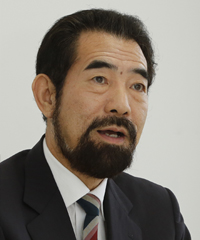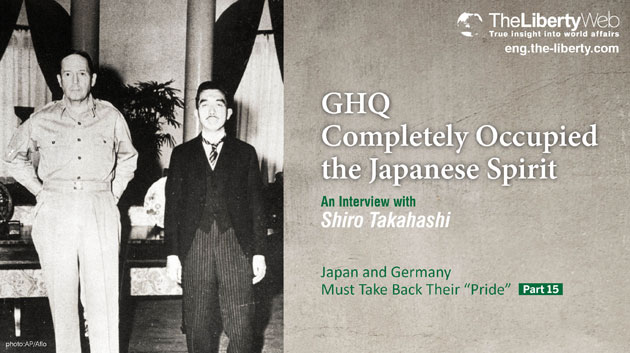GHQ Completely Occupied the Japanese Spirit
An Interview with Shiro Takahashi

Shiro Takahashi
Professor at Meisei University
Born 1950, Hyogo Prefecture. After graduating from Waseda University Graduate School, became visiting researcher at Stanford University’s Hoover Research Center. Served in government subcommittee of review council for strategic key measures for declining birthrate, incumbent. Serving in government council for gender equality. His numerous works include, “The U.S. Having Gone for the Occupation Period So That Japan Would Never Stand Up,” (Chichi Publishing).
The American Occupation after the war continues to have a negative impact on the thoughts and minds of contemporary Japan. So then, under what sort of rationale has America carried out its actions? We asked Shiro Takahashi who read through 2,500,000 pages of Occupation documents, and has conducted research on the Occupation for some 30 years.
The Occupation policies of Japan by the GHQ (note 1) were carried out based on the misguided perspective of the Japanese. At the source of the Occupation is a scholar on Shintoism from America named Holtom.
He confused Shintoism with “militarism”. The social anthropologist, Gora, who thinks along the same vein, advocates an extreme hypothesis, stating, “The Japanese, due to their extremely harsh toilet training when young, as part of their traditional education, have a collective obsessive-compulsive disorder.”
Professional Anti-Japanese Propagandists Led the Educational Reform After the War
Such research was inherited by the COI and the OWI, which were precursors to the CIA. There professionals who were conducting anti-Japanese psychological propaganda since the war were situated, and after the war many of them became officials in the CIE that was part of the GHQ.
That is, it was the anti-Japanese propagandists who had misunderstood Japan that led the educational reform in Japan. The source of the Occupation policies have become clear from recent research.
They had misleadingly assumed that “militarism is naturally rooted” in the Japanese, so that even if Japan’s armament was temporarily eliminated, unless their spirit and tradition was crushed, Japan would once again become a threat militarily.
For this reason the GHQ tried to destroy Japan’s traditional spirit with the “War Guilt Information Program,” that is the “propaganda strategy for inserting war guilt consciousness in Japanese”. They called this the “spiritual disarmament”.
Nurturing Anti-Japanese to Destroy from Within
The GHQ used Japanese with anti-Japanese sentiments.
For instance, at the time, there were censorship checks to see if there were any publications against the Occupation policies. The GHQ had 5,000 well-paid Japanese to overlook it. The truth is, those Japanese made up the core of the post-war dialogue, academia, and education.
All this is to say the GHQ nurtured Japanese who could be used for anti-Japanese propaganda, and would, even after they were gone, expand the “occupational policies” by the Japanese themselves, and set the direction so that they would self-destruct.
Moreover, there was a manual that teachers were required to read thoroughly after the war called, “Shin Kyouiku Shishin (New Education Guidelines)”. In its preface it is written, “Japan’s misdeeds have their root in the fact that there are numerous weaknesses in the way the Japanese think.” Basically, post-war education started with psychological self-denial.
It was the same with the media. On August 15th, when defeat was determined, the Asahi Newspaper, which is now strongly critical of Japan, had an article entitled, “Clutching Gravel and Praying to Miyagi, Shedding Tears”. It was about how a reporter from the Asahi papers wept in front of the Imperial Palace and couldn’t speak after screaming, “Apologies to the Emperor.”
However, a month later, Asahi received an order of suspension of publishing. It was the worst situation for a newspaper company. After that, to avoid further orders prohibiting being able to publish, they started to write articles from the “eyes of the GHQ”. At first they were probably conscious of what they were doing, but in time it became internalized and subconsciously they came to write from that perspective. America foisted upon them an “artificial eye”. It is for this reason that the domestic media got all up in arms whenever the Prime Minister recently visited the Yasukuni Shrine.
The Japanese Spirit Was Devastated as Ethics Could Not Be Taught
In the history of the world there have been many wars and occupation policies, but the occupation of Japan by the GHQ was an especially thorough and psychological one.
As a result, the Japanese spirit was devastated. For instance, there are many parents who are failing as parents recently. Criminal activity perpetrated by children, especially theft, is getting younger, and parents do not feel guilty about it. Not only that, but theft by people over 60 is on the rise.
In the background is the fact that due to the chain of negative post-war education for over three generations, the Japanese have lost their pride and confidence, and lost their traditional morality and spirit. Tradition and ethics governing the raising of children has been destroyed, and the spirit of children and grandchildren has been devastated.
I was fortunate enough that my father made me read books like Sanai Hashimoto’s “Keihatsu Roku,” or Ryotaro Shiba’s “Ryoma ga Iku,” and learned about the greatness of Japan’s history and traditional thinking, and understand their significance.
As Japan’s education is withered from its roots, and the branches are also beginning to rot as well, a symptomatic institutional reform can not rebuild it. It is necessary to take back the foundation of the Japanese spirit.
Note 1 Allied Supreme Commander General Headquarters. It was the Allied institution that carried out the occupation policies of Japan, but many of the personnel were Americans.
Related
- How and for What Did Germany and Japan Apologize?:Japan and Germany Must Take Back Their "Pride" Part 10
- "Germans Are Unable to Express Their Patriotism":An Interview with Professor Ernst Nolte
- Germans Lost Diligence After the War : An Interview with Emi Kawaguchi-Mahn
- Was President Roosevelt Truly a "Hero"? - Japan and Germany Must Take Back Their "Pride" (Part 13)
- Roosevelt Deceived the American Citizens and Congress : Japan and Germany Must Take Back Their "Pride" (Part 14)



















